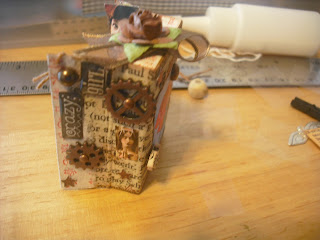Two by Land--Katherine Sandoz and Nicole Donnelly at the
Sheppard Gallery
I attended the exhibit, but I was unable to get
an artists' statement--the desk area was pretty busy, but I enjoyed the art.
I am sure this exhibit is called "Two by Land", not only
because there are 2 artists, but because their works are similar, but
different. One uses more of the textural technique and images, while one
used bands of color to represent landscape views. The color choice would remind
you of a landscape you saw somewhere, but the muted quality of the colors
suggest that this is from a memory--you can remember some of the shapes, and
the colors, but the details are not quite clear. #5 does this for me: we can see that it
is a rock or hill, but the sediment layers are visible. It reminded me of the
passage between Valencia and the north part of the San Fernando Valley in Los
Angeles when you are traveling on Intersate 5. This is the San Andreas Fault
rift zone, and you can see the shape of the rock, but the exact location is a
bit vague in a memory.
The artist that used the textural techniques
appears as though she might have used acrylics--some of the techniques used
were almost like a resist, and there was also using and incorporating dripping
paint into the work. For example, #13 use the drips as tree
roots. The works were abstract landscapes, with a few that had
recognizable images, such as a castle and the sails rigging on a large
ship. The rigging was painted white on a background that mixed broad
sweeps with the resist technique peeking from underneath. The ship reminded me of the Balclutha, a
large, old cargo ship at the Maritime Museum in San Francisco. The artist that chose to use the bands of
color used color to illustrate the layers of landscape--a familiar yet unknown
view from the highway of mountains, some close and some far.
I thought this exhibit did a great job of evoking
memory. Sometimes when we travel, we see
something, through the fog or in the distance, and we remember it. It reminded the viewer to take in the broader
picture, and not just the details.
Persuasion—text,
placement and word use--Priscilla B. Varner at the Mc Namara
I began by reading the
artist’s statement. Varner says that printed words can be used and placed in
certain ways to evoke emotion. Words can
change the mood of what we read: a “small
gathering of protesters” can be inflated to “angry mob,” sparking emotion in the
reader. Varner used photos, paired with
a list of words hanging side by side—one word per line—intending to describe
the picture in various ways.
The first work I noted this in was “Juillet.” The word was painted in dark gray or
weathered black block letters on a white wall, with tree branches hanging over
the wall. The words next to it were “anniversary, monumental, reconciliation, revolutionary,
rights, unity.” And yes, those two
words were printed in a fancy font. After
a short search, I found out that ‘juillet’ means ‘July’ in French. Now I could
understand more about the picture:
someone’s wedding anniversary could have been in July, July is the month
of Bastile Day in France, and perhaps July is also a month for other
things. In our country, it is the month
for summer and the 4th of July, so ‘rights’ might have meaning for
us in the United States.
Another example of word use is from a work called “des
Rangees”, which is a photo of large chairs in a grand theatre, with little
golden ornaments on top of the chairs that appear to be covered in velvet. Three
of the words used are ‘luxurious,’ ‘warm’ and ‘opulent.’ Luxury means an
expensive lifestyle to me, while opulent means expensive and over-decorated. The
scene all depends on the word used to describe it, and that is what Varner
wants us to do.
Wood, Paper, Etc—Walter McNamara at Sierra Arts Gallery
(OK, so didn’t take notes when I was there, and I don’t recall names of
pieces, but I will do my best here…) I had never seen McNamara’s work, so I was
intrigued. So many times collage and mixed
media work just looks like a mish-mash of garbage put together with no purpose
or meaning, but his works combine material and technique in a very interesting
way. This exhibit was interesting to me,
from a crafter’s point of view, because I enjoy using mixed media myself, and I
wanted to see what a “real” artist does.
I don’t use a lot of
wood, but McNamara combines wood with other materials, making a subtle
statement about outdoor life here in Nevada. There is art in a tree limb or branches.
I also like the message that comes from the pieces he created out of our
garbage—each piece is a piece of our own modern lives, formed to create
something usable from what we thought was no longer usable.










